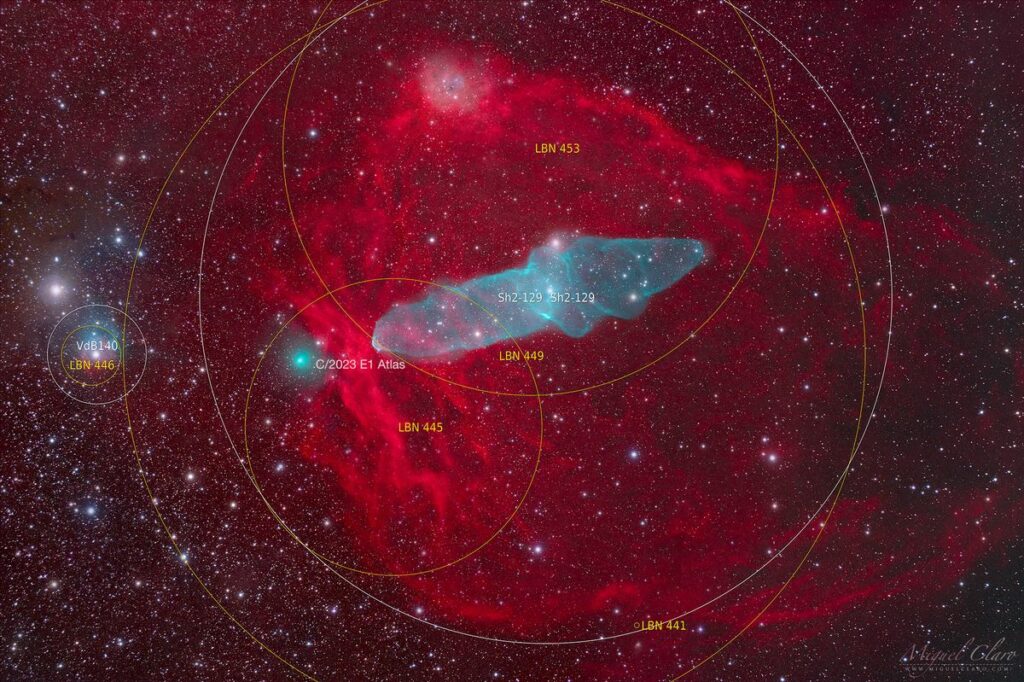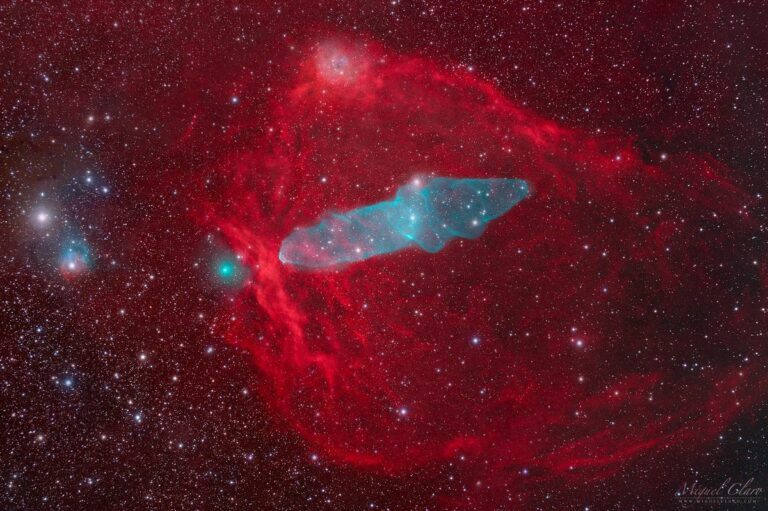Astrophotographer Captures Rare Encounter of Comet C/2023 E1 Atlas with the Flying Bat and Squid Nebula
The detailed deep-sky image captured by astrophotographer Miguel Claro shows the dramatic scene unfolding at different wavelengths.
In this stunning deep-sky photograph, Miguel Claro has captured nebulas, stars and a Periodic Comet that orbits the Earth after every 85 years.
The picture is in Ha, OIII and RGB wavelengths showing a large reddish cloud of violently glowing hydrogen, often called the Flying Bat Nebula or Sh2-129. This one is 271 light-years large and seems to fit the bluish Squid Nebula galaxy, which is 50 light-years across the center of this nebula.
The so-called Squid Nebula which is a rather weak planetary can be found in the constellation of Cepheus, it was the French astrophotographer Nicolas Outters who first noticed this object in 2011. Its bipolar morphology, illustrated by doubly ionized oxygen atoms’ blue-green coloration, is one of the best aspects of this astrographic work.
A greenish sphere is visible at the border of the Flying Bat Nebula’s reddish wings: it is not a new type of nebula, but a Comet C/2023 E1 Atlas encounter. This comet radiates with a magnitude of only 14. 7 magnitude, takes 85 years to orbit the Sun at an average distance of 19 Astronomical Units (AU); one AU defined as the average of EDT and WDT (Earth and Sun distance) that is about 149.

Over the course of 11 nights in July and August, I was photographing the Flying Bat Nebula, the total integration time of which is 39. 5 hours. Luckily, I managed to shoot Comet C/2023 E1 Atlas on 5th August 2023 in the early evening, 7 p. m. ET or 2300 GMT, through the Anti-Halo PRO Dual-Band 3nm filter by Player One. I was able to capture the green coma in my filtered light when shooting Ha and OIII at the same time since the OIII emission in G and B channels matched the green emission of the comets. The only thing that would have been lost if I had only used Ha was that it was completely invisible in the narrowband red channel.
On the left side of the overall picture it is possible to notice VdB 140 and LDN 446. The above photo was taken at the Dark Sky Reserve Alqueva Observatory in Cumeada Portugal using Poseidon-C Pro Camera.
If you like this kind of astrophotography and wish to see more of the ‘making-of,’ you can find me on Instagram at Miguel Claro Astrophotography @miguel_claro. You may also want to learn more about the equipment that I use which I have posted on my personal website.
Fine art prints

I hope you enjoy this photo as much as I do! If you’d like to support my work as an independent artist, consider purchasing this image as a print to add a unique piece of art or wall decoration to your home. You can explore various sizing options and print types below, or feel free to contact me if you need any assistance. I’m also planning a limited edition Print Drop in the near future, which will be available in my print gallery. In the meantime, you can sign up for my newsletter to get early access.
Do not forget to share your opinion with us to provide you with the best posts !




0 Comments